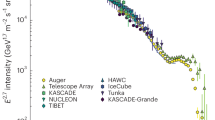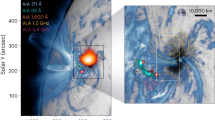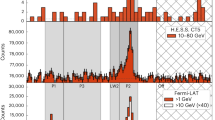Abstract
Low-frequency cutoffs were first observed in the radiation spectra of several pulsars about a decade ago1. The detailed study of the low-frequency (ω≲100 MHz) radio emission spectra of more than 50 pulsars2–7 has shown that practically all pulsars observed have low-frequency cutoffs in their spectra. In most pulsars the spectral cutoffs are an inherent feature of pulsar emission and are obviously associated with the emission mechanism8. The most favoured hypothesis at present is that the radio emission of pulsars is a curvature radiation of charged plasma bunches that move, with a Lorentz factor of Γ ≅ 103, practically along curved magnetic field lines9,10. The kinetic energy of plasma bunches is comparable with the brightness temperature of radio emission measured in energy units. Hence, the reabsorption of the curvature radiation by the radiating plasma bunches themselves may be essential for the formation of the radio emission spectra of pulsars. Here we show that this radiation reabsorption may be responsible for low-frequency cutoffs in the pulsar radio emission spectra.
This is a preview of subscription content, access via your institution
Access options
Subscribe to this journal
Receive 51 print issues and online access
$199.00 per year
only $3.90 per issue
Buy this article
- Purchase on Springer Link
- Instant access to full article PDF
Prices may be subject to local taxes which are calculated during checkout
Similar content being viewed by others
References
Sieber, W. Astr. Astrophys. 28, 237–252 (1973).
Kuzmin, A. D. et al. Mon. Not. R. astr. Soc. 185, 441–449 (1978).
Bruck, Yu. M. et al. Sov. astr. J. 55, 1031–1039 (1978).
Izvekova, V. A., Kuzmin, A. D., Malofeev, V. M. & Shitov, Yu. P. Sov. astr. J. 56, 322–337 (1979).
Izvekova, V. A., Kuzmin, A. D., Malofeev, V. M. & Shitov, Yu. P. Aust. J. Phys. 32, 25–38 (1979).
Malofeev, V. M. & Malov, I. F. Sov. astr. J. 57, 90–106 (1980).
Izvekova, V. A., Kuzmin, A. D., Malofeev, V. M. & Shitov, Yu. P. Astrophys. Space Sci. 78, 45–72 (1981).
Manchester, R. N. & Taylor, J. H. Pulsars (Freeman, San Francisco, 1977).
Sturrock, P. A. Astrophys. J. 164, 529–556 (1971).
Ruderman, M. & Sutherland, P. Astrophys. J. 196, 51–72 (1975).
Ochelkov, Yu. P. & Usov, V. V. Astrophys. Space Sci. 69, 439–460 (1980).
Arons, J. Proc. IAU Symp. No. 94, 175–203 (1981).
Author information
Authors and Affiliations
Rights and permissions
About this article
Cite this article
Ochelkov, Y., Usov, V. The nature of low-frequency cutoffs in the radio emission spectra of pulsars. Nature 309, 332–333 (1984). https://doi.org/10.1038/309332a0
Received:
Accepted:
Issue Date:
DOI: https://doi.org/10.1038/309332a0
This article is cited by
-
High-frequency cutoff and change of radio emission mechanism in pulsars
Astrophysics and Space Science (2013)
-
Theory of the radio emission of pulsars
Astrophysics and Space Science (1988)
Comments
By submitting a comment you agree to abide by our Terms and Community Guidelines. If you find something abusive or that does not comply with our terms or guidelines please flag it as inappropriate.



